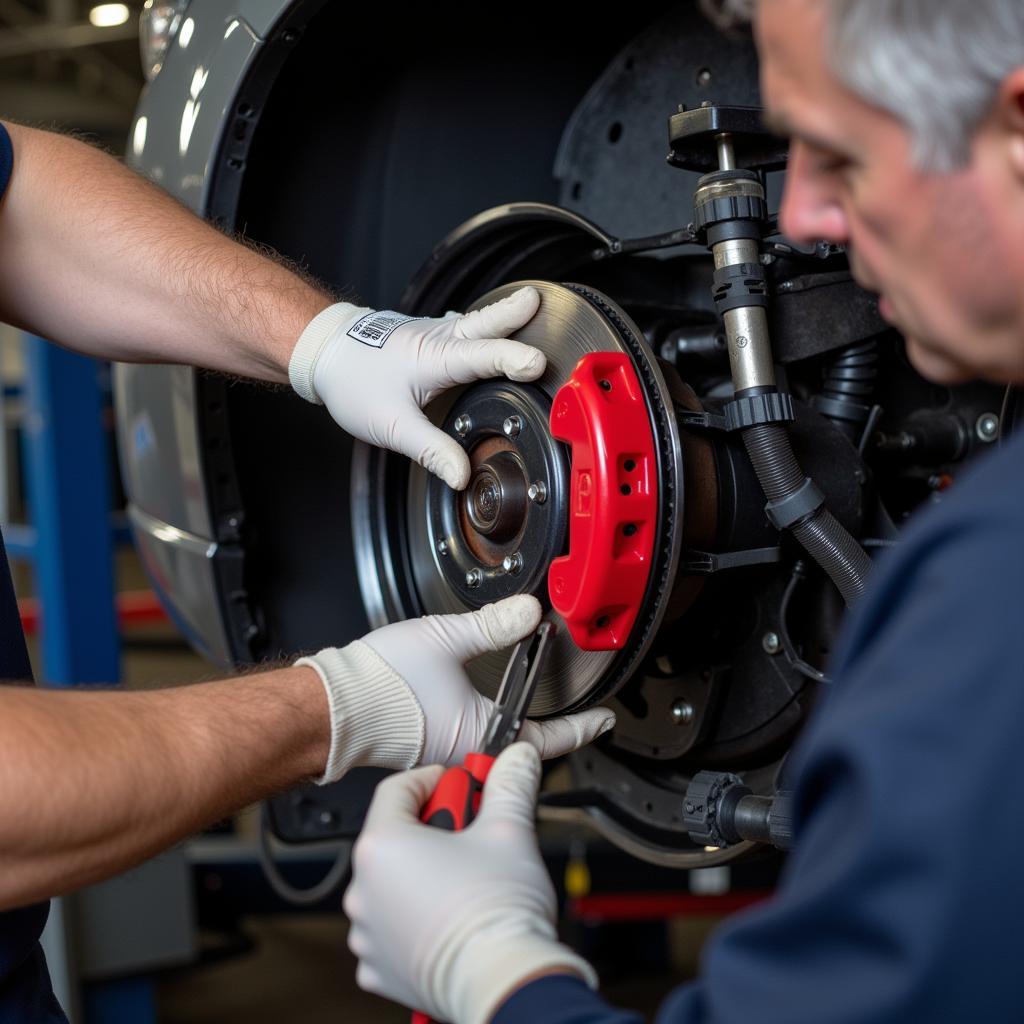The red brake lamp warning light on your dashboard, sometimes flashing “NYSI,” can be a nerve-wracking experience. Understanding what “does red brake lamp warning light fail NYSI” means, and how to address it, is crucial for your safety and the proper functioning of your vehicle. This article will delve into the common causes of this warning, provide troubleshooting steps, and discuss solutions, including remote software programming and installation options.
Understanding the Red Brake Lamp Warning Light and “NYSI”
The red brake lamp warning light illuminates when there’s an issue with your braking system. While “NYSI” itself isn’t a standard automotive acronym, it likely points to a communication error within the vehicle’s network, specifically related to the brake system. This could be due to a faulty sensor, wiring problem, or a software glitch in the car’s control modules. Ignoring this warning can lead to dangerous driving conditions, so addressing it promptly is vital.
Common Causes of the Red Brake Lamp Warning Light
Several issues can trigger the red brake lamp warning light, sometimes accompanied by unusual codes like “NYSI.” These include:
- Faulty Brake Light Bulbs: The most common and easily fixable cause.
- Blown Fuses: A blown fuse related to the brake lights can also trigger the warning.
- Brake Light Switch Malfunction: This switch, located near the brake pedal, can fail, preventing the lights from activating.
- Wiring Problems: Damaged or corroded wires in the brake light circuit can disrupt the signal.
- Faulty Brake Fluid Level Sensor: Low brake fluid can activate the warning light as it indicates a potential leak or wear in the braking system.
- ABS Module Issues: Problems with the Anti-lock Braking System (ABS) module can also trigger the warning light, especially if accompanied by a “NYSI” code.
- Software Glitches: In modern vehicles, software glitches in control modules can also affect the brake light system.
Troubleshooting the Red Brake Lamp Warning Light
Here’s a step-by-step guide to help you troubleshoot the issue:
- Check the Brake Light Bulbs: Inspect all brake light bulbs for damage or burnout. Replace any faulty bulbs.
- Check the Fuses: Locate the fuse box and check the fuse related to the brake lights. Refer to your owner’s manual for the correct fuse location. Replace the fuse if it’s blown.
- Inspect the Brake Light Switch: Check the brake light switch for proper operation. It should click when the brake pedal is depressed. Replace the switch if necessary.
- Examine the Wiring: Visually inspect the wiring connected to the brake lights for any signs of damage, corrosion, or loose connections. Repair or replace any faulty wiring.
 Mechanic Checking Brake Light Bulbs
Mechanic Checking Brake Light Bulbs
- Check Brake Fluid Level: Ensure the brake fluid reservoir is filled to the appropriate level. Low brake fluid could indicate a leak and requires immediate attention.
- Scan for Diagnostic Trouble Codes (DTCs): If the basic checks don’t reveal the problem, use an OBD-II scanner to retrieve any stored diagnostic trouble codes. These codes can pinpoint the specific area of the braking system causing the issue.
Remote Software Programming and Installation: A Modern Solution
In some cases, the “NYSI” code might indicate a software-related issue within the vehicle’s control modules. This is where remote software programming and installation come into play. With advancements in automotive technology, many issues can be diagnosed and resolved remotely by expert technicians. This process involves connecting to your vehicle’s onboard computer system via a secure internet connection and installing or updating the necessary software. This can address software glitches, communication errors, and even optimize the performance of the braking system.
Addressing ABS Module Issues and “NYSI” Codes
If the diagnostic codes point to the ABS module, remote software updates might be required. An expert in remote automotive software services can remotely diagnose and resolve the problem, saving you time and potentially costly repairs. This method can be particularly effective in resolving issues related to the “NYSI” code, which often suggests a communication problem within the car’s network.
Conclusion
The red brake lamp warning light, especially when accompanied by “NYSI,” demands prompt attention. While simple fixes like replacing bulbs or fuses can often resolve the issue, more complex problems might require professional diagnosis and potentially remote software programming and installation. By understanding the potential causes and troubleshooting steps, you can ensure your vehicle’s safety and avoid potential hazards on the road. Don’t hesitate to seek expert help if you’re unable to diagnose the problem yourself. Remember, a properly functioning brake system is paramount for your safety and the safety of others.
FAQs
- What does “NYSI” mean on my dashboard? “NYSI” is not a standard automotive code. It likely indicates a communication error within the car’s network, possibly related to the brake system.
- Can I drive with the red brake lamp warning light on? It’s highly discouraged. Driving with a faulty braking system can be extremely dangerous.
- How much does it cost to replace a brake light bulb? Brake light bulbs are generally inexpensive, typically costing a few dollars each.
- What is remote software programming and installation? It’s a method of diagnosing and fixing car problems remotely by updating or installing software on the vehicle’s control modules.
- Where can I find a qualified technician for remote software services? Contact specialized automotive repair shops or dealerships that offer remote diagnostic and programming services.
- Can I fix a software glitch myself? Unless you have specialized training and equipment, it’s best to leave software-related issues to professionals.
- Is remote software programming safe for my car? Yes, when performed by qualified technicians using secure connections and approved software, it’s a safe and effective method of repair.

